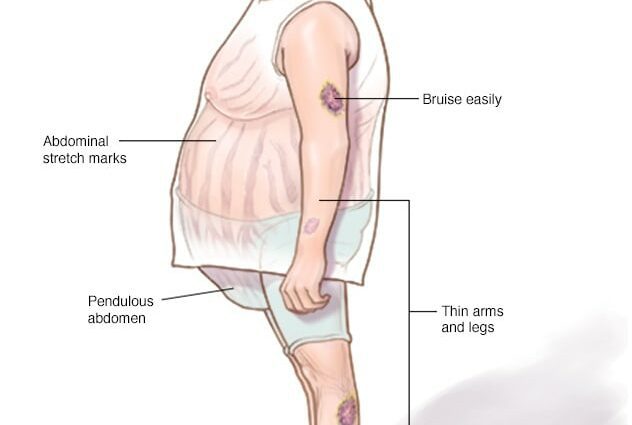Contents
Cushing’s Syndrome
What is it ?
Cushing’s syndrome is an endocrine disorder linked to the body’s exposure to too high levels of cortisol, a hormone secreted by the adrenal glands. Its most characteristic trait is obesity of the upper body and face of the affected person. In the vast majority of cases, Cushing’s syndrome is caused by taking anti-inflammatory drugs. But it can also have a cause of endogenous origin, such as Cushing’s disease, which is very rare, from one to thirteen new cases per million people and per year, according to the sources. (1)
Symptoms
Abnormally high cortisol levels result in a host of signs and symptoms. The most striking are the weight gain and the change in appearance of the sick person: fat accumulates in the upper body and neck, the face becomes round, puffy and red. This is accompanied by a loss of muscles in the arms and legs, to such an extent that this “atrophy” can hamper the mobility of the person affected.
Other symptoms are observed such as thinning of the skin, the appearance of stretch marks (on the stomach, thighs, buttocks, arms and breasts) and bruises on the legs. The significant psychological damage due to the cerebral action of cortisol should not be neglected either: fatigue, anxiety, irritability, sleep and concentration disturbances and depression affect the quality of life and can lead to suicide.
Women can develop acne and excessive hair growth and experience menstruation disruption, while men’s sexual activity and fertility decline. Osteoporosis, infections, thrombosis, high blood pressure and diabetes are common complications.
The origins of the disease
Cushing’s syndrome is caused by excessive exposure of tissues in the body to steroid hormones, including cortisol. Cushing’s syndrome most often results from taking synthetic corticosteroids for their anti-inflammatory effects in the treatment of asthma, inflammatory diseases, etc., orally, as a spray or as an ointment. It is then of exogenous origin.
But its origin can be endogenous: the syndrome is then caused by the excessive secretion of cortisol by one or both adrenal glands (located at the top of the kidneys). This happens when a tumor, benign or malignant, develops in an adrenal gland, in the pituitary gland (located in the skull), or elsewhere in the body. When Cushing’s syndrome is caused by a benign tumor in the pituitary gland (a pituitary adenoma), it is called Cushing’s disease. The tumor secretes excess corticotropin hormone ACTH which will stimulate the adrenal glands and indirectly the excessive secretion of cortisol. Cushing’s disease accounts for 70% of all endogenous cases (2)
Risk factors
Most cases of Cushing’s syndrome are not inherited. However, this can occur due to an inherited genetic predisposition to the development of tumors in the endocrine, adrenal, and pituitary glands.
Women are five times more likely than men to get Cushing’s syndrome caused by an adrenal or pituitary tumor. On the other hand, men are three times more exposed than women when the cause is lung cancer. (2)
Prevention and treatment
The goal of any treatment for Cushing’s syndrome is to regain control of the excessive secretion of cortisol. When Cushing’s syndrome is drug-induced, an endocrinologist readjustes the causal treatment. When it is the result of a tumor, treatment by surgery (removal of the adenoma in the pituitary gland, adrenalectomy, etc.), radiotherapy and chemotherapy, is used. When it is not possible to completely eradicate the causative tumor, drugs that inhibit cortisol (anticortisolics) or inhibitors of the hormone ACTH may be used. But they are delicate to implement and their side effects can be severe, starting with the risk of adrenal insufficiency.










